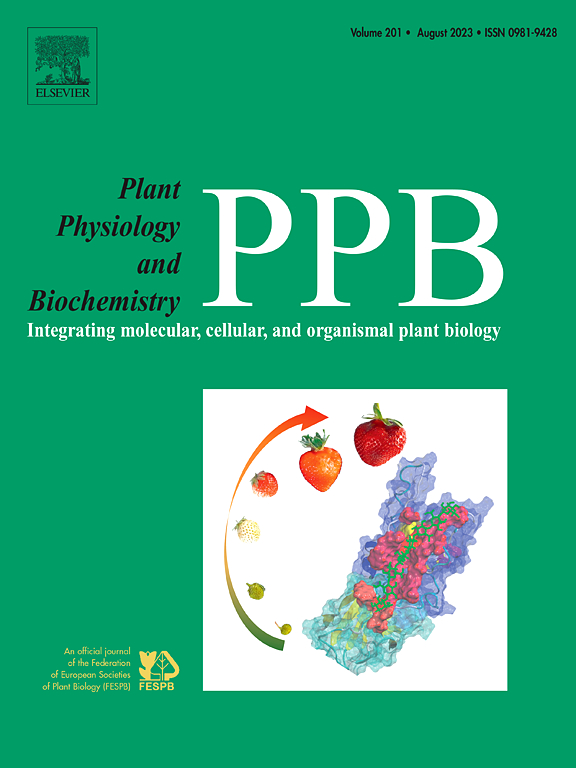Iron oxide nanoparticles (FeO-NPs) mitigate salt stress in peanut seedlings by enhancing photosynthesis, osmoregulation, and antioxidant activity
IF 5.7
2区 生物学
Q1 PLANT SCIENCES
引用次数: 0
Abstract
Soil salinization constitutes a major constraint to agricultural sustainability worldwide, with elevated sodium chloride levels inducing complex physiological disruptions that compromise crop productivity. As an innovative approach to abiotic stress mitigation, iron oxide nanoparticles (FeO-NPs) demonstrate unique advantages in enhancing iron bioavailability and modulating plant stress responses. This investigation systematically evaluated the efficacy of FeO-NPs in ameliorating NaCl-induced stress (150 mM) in peanut (Arachis hypogaea L.) through foliar application of nanoparticle gradients (0, 25, 50, 100 mg/kg), with particular emphasis on photosynthetic apparatus protection and redox homeostasis regulation. Results demonstrated that salt stress significantly reduced growth parameters, photosynthetic pigments, gas exchange, and chlorophyll fluorescence, while elevating oxidative stress markers and antioxidant enzyme activities. Notably, FeO-NP application at 50 mg L−1 demonstrated optimal efficacy in counteracting salinity effects. Treated plants exhibited remarkable recovery in morphological parameters, achieving 20.13–68.67 % greater shoot/root elongation and 36.18–53.20 % higher biomass accumulation compared to salt-stressed controls. The nanoparticles significantly enhanced photosynthetic performance through multiple mechanisms: including elevated chlorophyll, restored carotenoids, higher net photosynthesis (Pn), alongside improved stomatal conductance (Gs) and PSII efficiency (Fv/Fm). The protective mechanism of FeO-NPs involved to cellular homeostasis regulation, augmented accumulation of osmolytes (proline, soluble proteins, sugars) and significant enhancement of antioxidant system components, including elevated activities of SOD, POD, and CAT. These coordinated responses effectively mitigated oxidative damage, reducing reactive oxygen species accumulation and lipid peroxidation (MDA) content relative to NaCl-treated plants. These findings highlight the application of FeO-NPs could be a promising strategy to enhance salt tolerance in peanuts through multi-faceted physiological and biochemical mechanisms.
氧化铁纳米颗粒(FeO-NPs)通过增强光合作用、渗透调节和抗氧化活性来缓解花生幼苗的盐胁迫
土壤盐渍化是全球农业可持续发展的主要制约因素,氯化钠水平升高会导致复杂的生理破坏,从而损害作物生产力。氧化铁纳米颗粒(FeO-NPs)作为缓解非生物胁迫的一种创新方法,在提高铁的生物利用度和调节植物胁迫反应方面显示出独特的优势。本研究通过叶面施用纳米颗粒梯度(0、25、50、100 mg/kg),系统评价了FeO-NPs对花生(Arachis hypogaea L.) 150 mM nacl胁迫的改善效果,重点研究了FeO-NPs对光合机构的保护和氧化还原稳态的调节作用。结果表明,盐胁迫显著降低了油菜的生长参数、光合色素、气体交换和叶绿素荧光,同时提高了氧化胁迫标志物和抗氧化酶活性。值得注意的是,50 mg L−1的FeO-NP应用在抵消盐度影响方面表现出最佳效果。与盐胁迫对照相比,处理后植株的形态参数恢复显著,茎/根伸长提高20.13 ~ 68.67%,生物量积累提高36.18 ~ 53.20%。纳米颗粒通过多种机制显著提高光合作用性能:包括提高叶绿素,恢复类胡萝卜素,提高净光合作用(Pn),以及改善气孔导度(Gs)和PSII效率(Fv/Fm)。FeO-NPs的保护机制涉及调节细胞稳态,增加渗透物(脯氨酸、可溶性蛋白、糖)的积累,并显著增强抗氧化系统成分,包括SOD、POD和CAT活性的升高。这些协同反应有效地减轻了氧化损伤,降低了活性氧积累和脂质过氧化(MDA)含量。这些发现表明,通过多方面的生理生化机制,应用FeO-NPs可能是提高花生耐盐性的一种有前景的策略。
本文章由计算机程序翻译,如有差异,请以英文原文为准。
求助全文
约1分钟内获得全文
求助全文
来源期刊
CiteScore
11.10
自引率
3.10%
发文量
410
审稿时长
33 days
期刊介绍:
Plant Physiology and Biochemistry publishes original theoretical, experimental and technical contributions in the various fields of plant physiology (biochemistry, physiology, structure, genetics, plant-microbe interactions, etc.) at diverse levels of integration (molecular, subcellular, cellular, organ, whole plant, environmental). Opinions expressed in the journal are the sole responsibility of the authors and publication does not imply the editors'' agreement.
Manuscripts describing molecular-genetic and/or gene expression data that are not integrated with biochemical analysis and/or actual measurements of plant physiological processes are not suitable for PPB. Also "Omics" studies (transcriptomics, proteomics, metabolomics, etc.) reporting descriptive analysis without an element of functional validation assays, will not be considered. Similarly, applied agronomic or phytochemical studies that generate no new, fundamental insights in plant physiological and/or biochemical processes are not suitable for publication in PPB.
Plant Physiology and Biochemistry publishes several types of articles: Reviews, Papers and Short Papers. Articles for Reviews are either invited by the editor or proposed by the authors for the editor''s prior agreement. Reviews should not exceed 40 typewritten pages and Short Papers no more than approximately 8 typewritten pages. The fundamental character of Plant Physiology and Biochemistry remains that of a journal for original results.

 求助内容:
求助内容: 应助结果提醒方式:
应助结果提醒方式:


